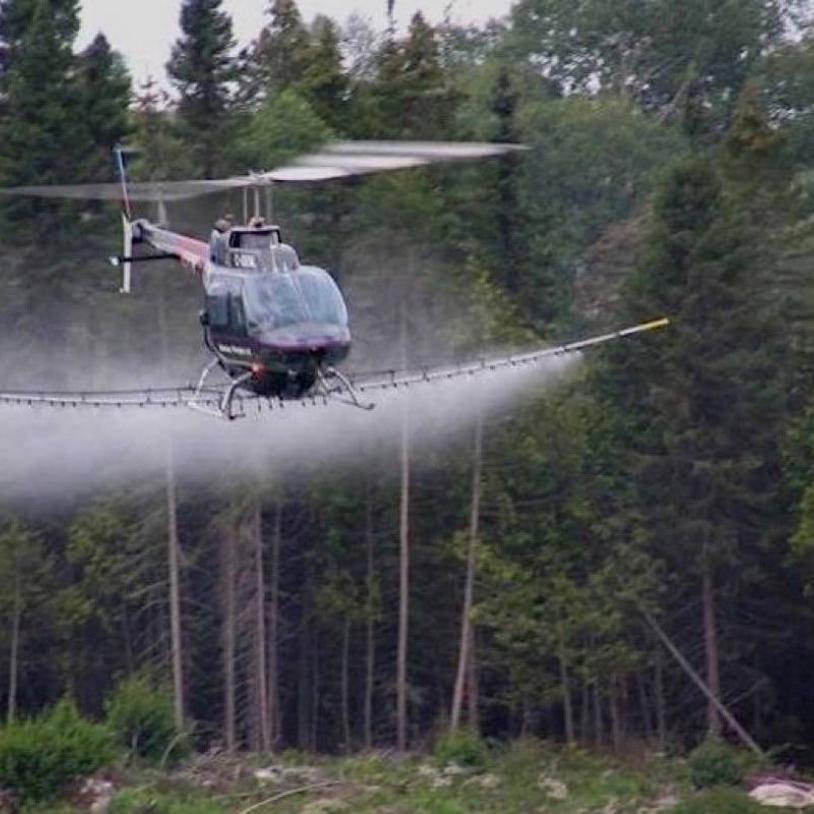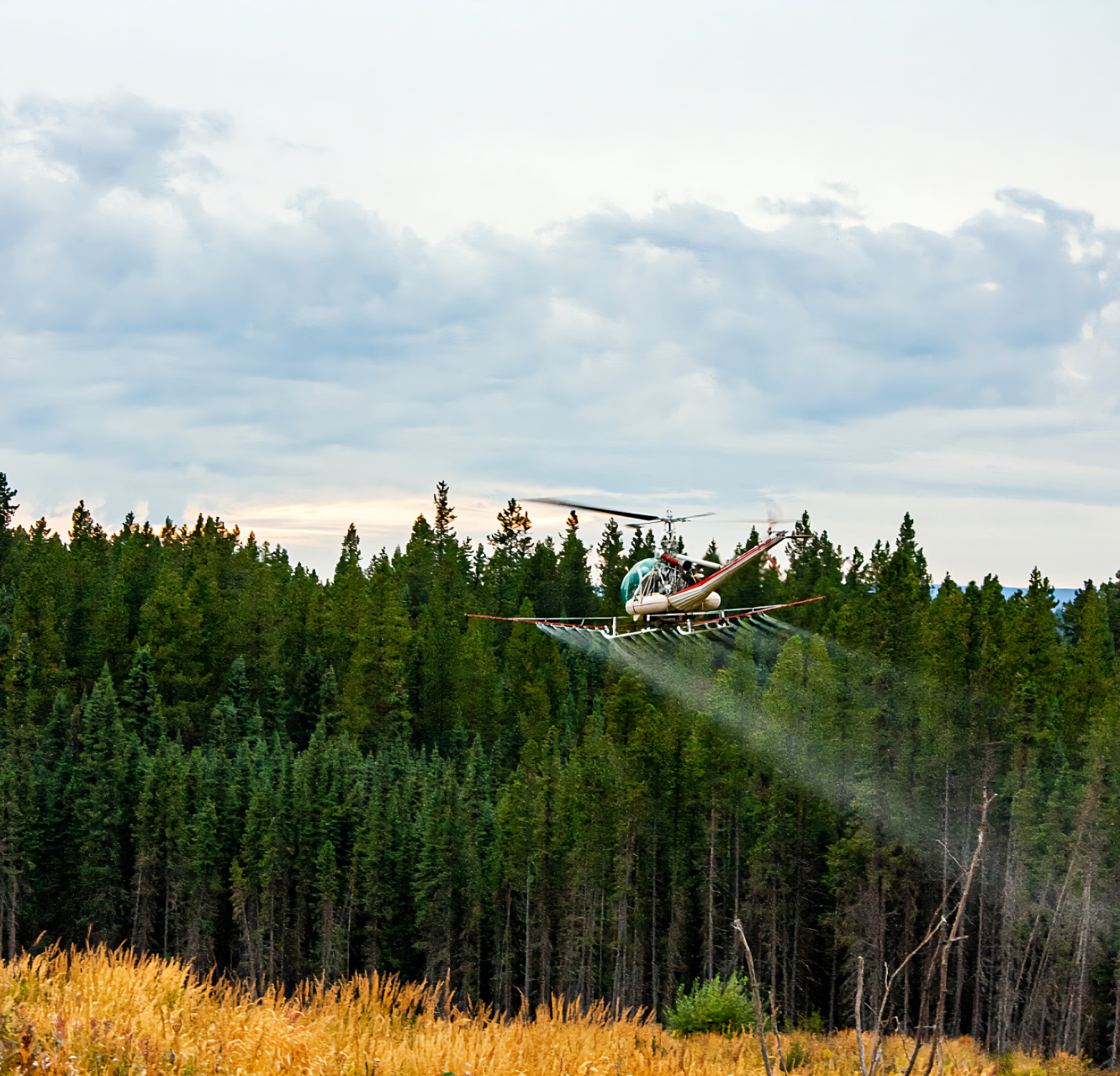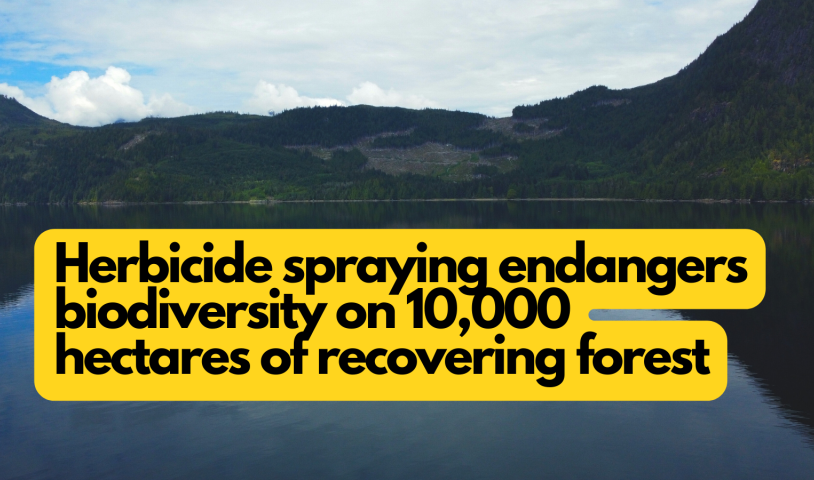A new pesticide act must put human and and ecological health first
Tuesday, July 5, 2022
RE: Consultation on Targeted Review of the Pesticide Control Products Act
The Canadian Association of Physicians for the Environment (CAPE-ACME), Environmental Defence, Wilderness Committee and Safe Food Matters Inc. welcome the opportunity to submit these comments in response to the consultation on the Targeted Review of the Pesticide Control Products Act, and in particular, Health Canada's Pest Management Regulatory Agency
(PMRA) Discussion Document, for Further Strengthening Protection of Health and the Environment: Targeted Review of the Pest Control Products Act (PCPA). Safe Food Matters Inc. supports and endorses the comments herein in addition to their own separate comment submission.
Background

CAPE-ACME is a national physician-led organization working at the intersection of health and the environment. As physicians and other health professionals with a record of research and advocacy around evidence-based and evidence-informed concerns relating to critical environmental health issues in Canada, CAPE has a long history of activity with regard to pest management and pesticide regulation to protect the environment and human health. We have been participating as stakeholders and steering committee members in the PMRA Transformation Agenda engagement opportunities.
Environmental Defence is a national environmental organization that has conducted pesticide research, led public engagement and encouraged policy reform. We are also participating in the PMRA Transformation consultations, and are deeply invested in reducing the impacts of pesticide use and exposures on the climate, biodiversity and human health.
Wilderness Committee is a national environmental non-profit organization that aims to protect wildlife habitat from destruction, pollution and toxins. For years we’ve been advocating for the reduction of neonicotinoid use in Canada by bringing attention to the dangers of these pesticides, mobilizing the public and through the federal court system. We went to Federal Court in November 2018 to challenge conditional registration of some Thiamethoxam pesticides, arguing they were unlawfully registered.
Safe Food Matters Inc. is a Canadian non-profit corporation, founded in 2016, dedicated to safe food and a safe environment. We work to improve regulatory policies to better protect human health and the environment. Our current topics are glyphosate, chlorpyrifos, and GM (genetically modified/edited products).
We recognize and note that transforming the pesticide program is a stated key priority for the PMRA and the targeted review of the PCPA is a mandate commitment for the Minister of Health.
Context for the Transformation
The PMRA transformation agenda and forthcoming legislative review of the PCPA will take place under unique circumstances that must inform their process design and planned outcomes.
We are living in an existential crisis as the climate emergency escalates. No planning of future legislative or regulatory actions in Canada can ignore this fact. Too often, we falter in approaches to solving critical problems by failing to see the bigger picture, suffering from siloed thinking and seeing variables as independent instead of interdependent and fundamentally connected. Pesticides can negatively impact soil biodiversity, which then can impact its carbon storage and sequestration abilities.
Climate change, toxic exposures, and environmental injustice are not separate phenomena. We must connect the dots and bring the bigger picture of planetary health into view as is done in The Lancet's manifesto for public health. The vision is “a planet that nourishes and sustains the diversity of life with which we coexist and on which we depend.”
Furthermore, it is critical to conceptualize the determinants of planetary health from a perspective that embodies Indigenous-specific methods of knowledge gathering and that recognizes Indigenous Peoples’ sovereignty has been adversely impacted by increasing effects of environmental change, including climate change, pollution, and threats against their land and water rights.
Authors of a recently published study conclude chemical pollution, including pesticides, has now crossed a “planetary health boundary” — the limits of nature to support human activity — and argue that stronger regulation and a cap on chemical production and release are necessary, as are carbon targets to end greenhouse gas emissions. The climate emergency requires solutions by way of swift action. Governments must dramatically reduce CO2 and greenhouse gas emissions through integrated policy measures. We cannot continue to allow our communities to be used as science labs.
Governments must take the approach that progress in addressing climate change and environmental health, justice and economics are the same goals, achievable with interconnected strategies. A well-being economy instead of a GDP-focused framework is needed, wherein just transitions for affected workers and communities are prioritized through a health lens and a quality of life framework. Just as targets have been set for the reduction of greenhouse gasses, so too should targets be set and met on pesticide use, such as the EU’s goal of 50% reduction in pesticide use by 2030.
Bringing the PCPA review into context
Decades of use of pest control products have provided us with significant evidence about the adverse human health and environmental impacts of pesticides. With the introduction of agricultural chemicals and mechanization of farm equipment after the second world war, causal negative health outcomes for workers and communities increased. Although pesticides were labour-saving and a boon to production, there were and are substantial human health costs. The “real-world data” cannot be overlooked.
For example, the families of Ontario farmers who used glyphosate experienced increased miscarriages and premature births. A case-control study in the agricultural area of Essex and Kent counties in Ontario found that breast cancer risk was elevated even among women who ever lived or worked on farms. Studies document pesticides in the bodies of pregnant women, in amniotic fluid, in the umbilical cord, and in mother’s milk. In Quebec, pesticides were found in 98.7% of children tested, and research shows that the long-ago banned DDT and its metabolites are still detectable in the breast milk of Inuit women in the North. Associations between exposure to pesticides and their contribution to cancers, reproductive problems, non-Hodgkin lymphoma, Parkinson’s disease and more can no longer be tolerated. These are not acceptable risks to pregnant people, cancer patients or anyone else.
Given the human health harms, and soaring costs of agricultural inputs, some farmers’ groups are urging governments to fund independent agricultural research, including research into affordable organic methods as well as to provide assistance to farmers making the transition into organic production. Farmers will benefit from a rapid transition to a low-input model, particularly if they seek to build healthy, carbon-sequestering soils.
We have so much information about the harm done by pesticides, the benefits of alternatives, the problem of environmental justice and the overreach of industry into government decision-making that we know that what we are eating and drinking is unlikely to be safe. Any reform agenda must place human and ecological health as the utmost priority, and this approach should shape all revisions to the Act. The PCPA should be strengthened to better achieve the primary objective of the act, and to reject any proposed amendments to the PCPA that would be contrary to this objective.
We support our colleagues at the David Suzuki Foundation who have developed the following priorities for the targeted review:
- Require the ministers of health and environment to develop a plan to reduce pesticide use and risk by 50 percent by 2030 in alignment with the EU, to align federal pesticide regulation with Canada’s commitment to halting and reversing nature loss.
- Expand requirements for assessing risks to vulnerable populations, workers and First Nations.
- Require assessment of cumulative risks to the environment, as well as human health, and broaden the definition.
- Explicitly require assessment of risks to species at risk and their critical habitats and more protective risk-acceptability thresholds.
- Require comparative assessments, with the goal of safer substitution, for active ingredients that are persistent, bioaccumulative, acutely toxic, carcinogenic, mutagenic, or endocrine-disrupting.
- Prohibit registration of cosmetic (lawn and garden) pesticides, except for minimum risk products.
- Establish in the act clear and robust parameters for any streamlined process designed to facilitate access to minimum risk pesticides.
- Regulate treated seeds under the PCPA.
- Develop integration decision-making and oversight on MRLs.
- Establish in the act national systems for reporting pesticide use and water monitoring. 11. Recognize the human right to a healthy environment.
Guiding Principles and Goals for this Feedback
As an overarching comment, we reiterate an earlier statement about the PMRA and the Government of Canada’s management of pesticides by pointing out that “gaps and flaws in this review process leave Canadians inadequately protected from health and environmental risks associated with the use of toxic pesticides.”
The review by the Federal Commissioner of the Environment and Sustainable Development in 2003 reported, “Overall, we conclude that the federal government is not managing pesticides effectively. We found weaknesses in many areas … raises serious questions about the overall
management of the health and environmental risks associated with pesticides.” The 2015 Commissioner’s review noted the PMRA “had not always acted in a timely manner to fulfill its statutory objective of preventing unacceptable risks to the health of Canadians and the environment from the use of pesticides.” The PMRA was the subject of a scathing audit in 2016 and as The Globe and Mail reported, the agency "allowed pesticides that it deemed as posing unacceptable risks to humans and the environment" to be used for several years. Canada has lower standards and is behind Europe in protecting the health of the people who live, work and play here.
The preamble of the Pest Control Products Act PCPA states it is “An Act to protect human health and safety and the environment by regulating products used for the control of pests…through the attainment of the objectives of the federal regulatory system continue to be pursued through a scientifically-based national registration system that addresses risks to human health and the environment both before and after registration and applies to the regulation of pest control products throughout” Canada. The PMRA states it is ”responsible for pesticide regulation in Canada.”
There is a cognitive dissonance between the PMRA and PCPA opening phrasing. One refers to “products used for the control of pests” where the other specifically says “pesticide regulation”. There are many effective and safe products and practices for the control of pests that are not chemical pesticides and that are not regulated under the Act. The conclusion ought to be, and corresponding PMRA activity should follow, that alternatives to chemical pesticides for the control of pests should include safe alternatives including nature-based solutions that can be applied without adverse outcomes of human, animal, and environmental or ecosystem health.
The conflicting approach leaves questions about which is the priority - the protection of human health and safety and the environment or sustainable use within an economic framework. The PMRA appears to tolerate numerous risks for economic benefit.
To fulfill the stated intent of human and environmental health and safety, the control of pest control products should centre on fundamental principles for public health and environmental protection including the application of the precautionary principle, harm or hazard prevention, health promotion, and environmental justice.
The assumption of the protection of human health and safety, as stated in that Act, should become the core goal of maintaining public health as a social good. The phrase public health was coined in the 19th century to distinguish between actions governments should take as opposed to private individuals to preserve and protect people’s health. To fulfill its mandate the PMRA must be clear on this distinction and not leave individuals the responsibility of making personal “choices” about potentially harmful exposures to pesticides when doing so often is largely out of their control whether due to lack of transparent information about risks or the inability to prevent exposures in their food, water, communities or workplaces.
The precautionary principle states that “when an activity raises threats of harm to human health or the environment, precautionary measures should be taken even if some cause and effect relationships are not fully established scientifically.” The approach is illustrated in the classic story of Dr. John Snow’s recommendation to officials in London, U.K., in 1854 to remove the Broad Street water pump handle to stem a cholera outbreak. When the pump handle was removed, the number of new cholera cases dropped dramatically. This approach — with the prevention of harm as fundamental — is equally applicable to the ubiquitous use of and unwitting exposure to pesticides.
Environmental justice principles were first outlined in 1991 by delegates to the First National People of Color Environmental Leadership Summit in Washington DC. Among others, the principles include demands that public policy be based on mutual respect and justice for all peoples, free from any form of discrimination or bias; affirming the right of all workers to a safe and healthy work environment without being forced to choose between an unsafe livelihood and unemployment; protecting the right of victims of environmental injustice; and considers governmental acts of environmental injustice a violation of international law, the Universal Declaration On Human Rights, and the United Nations Convention on Genocide.
Implementing UNDRIP and the recommendations of the Truth and Reconciliation Commission requires that we apply traditional Indigenous knowledge and evidence-informed approaches. (Note that CEPA says that in the administration of the Act the government shall “apply knowledge, including traditional aboriginal knowledge, science and technology to identify and resolve environmental problems”). Indigenous scientist Dr. Robin Wall Kimmerer reminds us we have the courage to “refuse to participate in an economy that destroys the beloved earth to line the pockets of the greedy, to demand an economy that is aligned with life, not stacked against it.”
There are inherent problems with the risk assessment approach used by the Government of Canada when contrasted with alternatives assessments within a hazard prevention paradigm. Alternatives assessments provide a realistic framework for chemical assessment with a reliance on assessing hazards and exposures, as opposed to probabilities of risk. The distinction between these paradigms is clearly articulated by toxicologist Dr. Margaret Whitaker here:
“Risk assessment is a powerful tool to assess the likelihood of harm, and if misused, has the potential to promote the continued use of substances that at sufficient levels of exposure may result in adverse human health and/or environmental effects. In contrast, an alternatives assessment begins with a different end game, and that is to inform the selection of less hazardous chemicals and materials so that the concept of acceptable risk is eliminated from the equation altogether.”
This is a conflict that was raised and posed as a question in a PMRA stakeholder meeting. We look forward to receiving an answer via email as indicated. The failure to answer whether the PMRA acknowledges the important distinction between these approaches and the implications for human and ecological health can only reasonably lead to the conclusion that harm prevention is not the priority, despite the language of the Act.
Correspondingly, alternatives to pesticides for pest control are well-established and fit within a planetary health framework that gives priority to the critical importance of biodiversity, organic approaches as well as “lower risk” or “minimum risk” substances such as are outlined in the US EPA document.
If the PMRA is committed to science-based action, then it should do so in keeping with biologist Mary O’Brien’s argument that “being a scientist means taking sides” and further that scientific skills “applied to these risk assessments generally does not serve infants, residents, workers…nearly as well as alternative assessments.” Taking the side of human health in the application of the PCPA of the future is our recommendation.
On Process
We acknowledge efforts by the PMRA to conduct a consultation and review process that would include stakeholder contributions, and we recognize that the scope and scale of such a process often exceeds the capacity to fulfill the best intentions for a meaningful and dialogical process.
Unfortunately, however, the consultation questions are narrowly scoped towards addressing regulated entities and their needs, as opposed to addressing the urgent needs of public health and public interest-focused decision-making.
The sheer volume and length of meetings required an enormous amount of time and commitment by stakeholders who already often struggle with capacity challenges, in particular in contrast with the well-funded industry stakeholders at the table. These dynamics would not be as great a concern if the process had transpired in such a way that stakeholder input - particularly from the NGOs, civil society organizations, marginalized, and vulnerable peoples -
was both received and responded to in a manner that reflected the gravity of the concerns being raised as well as the commitment from stakeholders who expect that our expertise and perspective would be granted the validity they deserve in such a process.
We are left feeling that the engagement opportunities fell both flat and short of providing real moments for substantive contributions from stakeholders that might be considered by the PMRA in its upcoming review of the PCPA. In addition, we are concerned about the seeming lack of formal recording of the contributions by stakeholders in meetings whether in conversation or via Q & A and chat functions of the virtual meetings. We were left wondering whether a formal record of these meetings will be forthcoming.
Despite the above-noted factors, we are grateful to be able to provide the following comments in response to the discussion document questions and are hopeful that this and other stakeholder submissions will add to the information that the PMRA will seriously consider moving forward.
Consultation responses
The following 22 recommendations build on the stated vision for both PMRA Transformation and strengthening the PCPA and advocate for an integrated approach to addressing multiple environmental health crises and government priorities. We support the submission and recommendations of our colleagues at Ecojustice, and have summarized and contributed to them below for your reference. The PMRA must acknowledge its role in providing support for alternative pest management strategies, and the PMRA management culture must change.
Modernized Business Practices – A lifecycle approach
Improved data requirements are needed to support the already required lifecycle approach.
1. End administrative or precedent renewals and amendments: Eliminate policies that support the use of purely administrative amendments and renewals, and convert the five-year renewal period to a legislative requirement.
2. Require more information be proactively required by registrants:
● Require information provided to other OECD regulators, including adverse risk information, and updated science in support of amendments and renewals
● Conduct literature searches and searches of foreign review documents as part of a pre-renewal screening to ensure compliance
● Mandatory registration consequences for failure to provide data.
3. Post-market data requirements need significant improvement:
● Take proactive and timely steps to remove PCPs and out-of-date labels from the market where uses are no longer supported and include the proposed process of its removal in the consultation discussion documents
● ensure that prolonged data gaps prior to or during a post-market review have immediate registration consequences
● Prioritize registration changes where there are delays in providing data, rather than allowing registrants to prolong post-market reviews with late or post-consultation data
4. Recall regime needs improvement: Add new recall provisions, recalling products and product labels where there is uncertainty as to the risk a product poses, data deficiencies or the product may pose a risk to human health or the environment.
5. Phase-out and cancellation are too slow and are not based on preventing unacceptable risks: ● Only permit continued possession and storage by users and retailers for up to three years, and registrants for up to five years where there are reasonable grounds to believe that immediate disposal would exceed disposal capacity, and set a deadline for disposal
● Order label recalls and replacements for registrants and retailers within one year where a label is amended and providing that retailers and distributors must notify customers of any changes to labels within one year
6. A lifecycle approach should support and not replace cyclical post-market reviews or renewals: ● Maintain periodic post-market reviews
● Maintain the current five-year renewal period and incorporate it into the Act ● Lower the threshold for OECD based and risk-based special reviews to include any proposed use restrictions and mitigation measures, not full cancellations
● Allow the Minister to expand the scope of special reviews
● Ensure that where a post-market review is underway no use expansions, increases in application rates, new registrations, or renewals can take place
● Require that post-market reviews shall be completed within three years or the product registration is automatically suspended and use and sale is prohibited until the completion of the review
7. Improving the use of independent science at the PMRA:
● Proactively provide published study protocols appropriate for regulatory use for independent researchers
● Create a more robust peer review system internally with clear documents peer reviews ● Ensure that notices of objection result in review panels more frequently
● Improve the Scientific Advisory Committee and ensure it is more transparent and independent, and used for specific registration decisions
Modernized business practices - Improve risk assessment, streamline low-risk products
1. Prioritize cancellation of higher-risk products in a less resource-intensive and delayed manner, and should not streamline a broad category of “lower risk” products, facilitating access to products with no risks/organics and IPM products and strategies:
● Clear and prescriptive legislative criteria for IPM pesticide authorizations or exemptions; limited to food-based products
● Clear and expressly-stated legislative purpose for any exceptions to the registration system focused on non-product-based strategies and IPM
● Must be consistent with the purpose of the Act which is already to ensure that only the lowest risk pesticides are permitted
● Must have a robust appeal mechanism for products that are misidentified appropriate for IPM
2. Consider alternatives as part of the value assessment: Amend the value provisions of the Act to allow the PMRA to refuse registration where lower risk alternative strategies or products are available
3. Risk assessment practices need to capture a wider range of risks:
● Require assessments to incorporate a comprehensive evaluation of the impacts of exposures, including cumulative impacts, specific windows of vulnerability for populations at risk including pregnant women, children, workers, Indigenous people and communities, as well as racialized people and communities as seen through the lens of environmental racism which recognizes geographic location and socioeconomic variables.
● Require assessment of cumulative health risks including synergistic, whole-mixture, component groupings, groupings by toxicological responses/effects, dose/concentration, and additional approaches, and physiologically-based modelling and component-based approaches
● Require assessment of occupational risks, including aggregate occupational risks and to apply ILO standards when assessing occupational risk
● Mitigation of occupational risk and residential exposure through the use of PPE should be the last line of defence and that heavy reliance on PPE to justify otherwise dangerous uses is not appropriate
● Require assessment of environmental justice and climate change, and the effects on species at risk
● Require consultation and consideration of Indigenous rights and traditional harvesting; require use of the PCPA factor in all cases
● Ensure that detailed toxicology information is provided on all formulants, adjuvants, impurities (including batch data), and complete residue chemistry for applications, amendments and renewals
● Amend internal EAD policies regarding ecological risk assessment decision-making and publicly consult on them
Transparency
1. Improved transparency requires a major internal culture shift:
● Require significantly improved documentation of scientific analysis and decisions at all decision and recommendation points
● Properly document how the PMRA considers the objectives of the Act and specific statutory criteria when making decisions, and make this improved documentation available to the public
2. Public registry needs significant improvement:
● Do not reduce the amount of information or the prescribed information that is required on the public registry under the existing Act;
● Improve the organization and level of detail of existing information on the registry.
3. Existing detailed registration consultations should be maintained:
● Continue to provide detailed consultation documents;
● Allocate more resources to translation, responding to information requests and access to information requests;
● Require public notice and disclosure for renewals, amendments that increase pesticide exposure and use expansions;
4. Improve public consultation and appeal mechanisms
● The Minister shall not consider new information in support of the registration of a product or a use from a registrant between the beginning of the public consultation period and the final decision, and that if any new information would increase a reference dose, or result in the
reversal of a use cancellation or mitigation measure there must be a further consultation period ● Create a stronger appeal mechanism with a low threshold for challenging a decision to permit a use or rely on a mitigation measure
● Create a “basket” discretion to disclose
5. Confidentiality needs to be more constrained
● Revoke the confidential test data provisions in the Act
● Allow a broad discretion to disclose confidential business information or test data ● Make a clear test for confidential business information such as harm to a commercial interest
6. Formal assessment of the scientific rigour of PRMA assessments by the new Chief Science Advisor, and in particular the potential (research-based) role of conflict of interest (COI) in influencing both evidence and the approach of the PMRA itself.
Real-World Data
1. Create clear policies that require that modelling cannot be disregarded as “overly conservative” but instead must be refined, and that recognize that real world data is often incomplete: ● Ensure easy public access to user and water monitoring data
● Ensure user data includes PPE use
2. The PMRA must eliminate heavy reliance on the GMRL:
● Limit of quantification as the “default” MRL in all cases
● Revoke or revise historic MRLs based on trade considerations rather than health ● Ensure field trial studies are provided and must link this to registration
3. Use dietary risk assessments to set MRLs:
● Use a lifecycle approach to MRLs and ensure they are reviewed when registration decisions including renewals and amendments are made
● Review the approach to the use of crop groupings
● Do not amend MRLs based on precedent registrations or qualitative assessments 4. MRLs need to be integrated with the PCPA:
● Make MRLs a condition of registration, and require a continuous obligation to ensure that MRLs pose acceptable risks
5. Import MRLs should also be a condition of registration, based on Canadian health risks; and import “uses” for food residue should be registered
6. Consultation on MRLs lacks transparency - requires consultation on all MRL increases
We support the government in its efforts to protect people and the environment from toxic chemicals and thank you in advance for your time. We look forward to your response to this submission in the near future.
Sincerely,
Jane McArthur
Toxics Program Director,
Canadian Association of Physicians for the Environment (CAPE)
Cassie Barker
Senior Program Manager, Toxics, Environmental Defence
Charlotte Dawe
Conservation and Policy Campaigners Wilderness Committee
Mary Lou McDonald, LL.B.
President, Safe Food Matters Inc.





